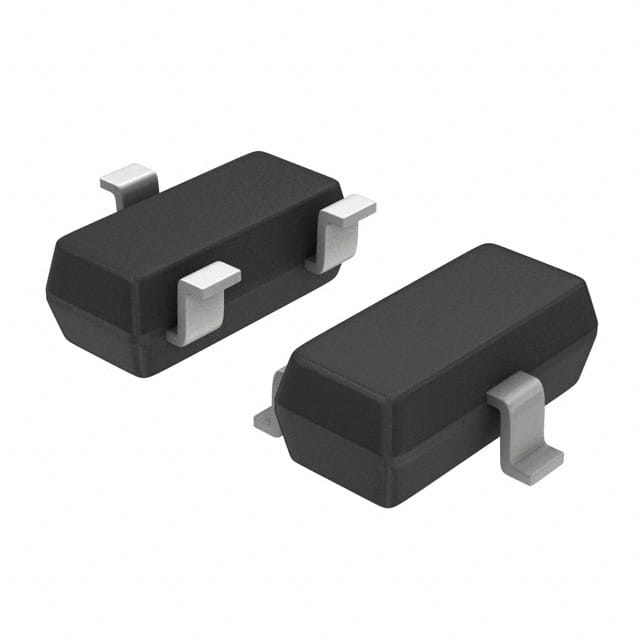Zie specificaties voor productdetails.

SMMBT3904LT1G - English Editing Encyclopedia Entry
Product Overview
The SMMBT3904LT1G belongs to the category of small signal transistors and is commonly used in electronic circuits for amplification and switching purposes. This NPN bipolar junction transistor (BJT) exhibits characteristics such as high voltage gain, low noise, and fast switching speed. It is typically packaged in a small SOT-23 package and is available in tape and reel packaging with a quantity of 3000 units per reel.
Specifications
- Maximum Collector-Base Voltage: 40V
- Maximum Collector Current: 200mA
- Power Dissipation: 225mW
- Transition Frequency: 250MHz
- Operating Temperature Range: -55°C to 150°C
Detailed Pin Configuration
The SMMBT3904LT1G features three pins: the emitter, base, and collector. In the SOT-23 package, the pin configuration is as follows: - Pin 1: Emitter - Pin 2: Base - Pin 3: Collector
Functional Features
This transistor offers high amplification capabilities, making it suitable for use in audio amplifiers, signal processing circuits, and radio frequency (RF) applications. Its fast switching speed enables efficient digital switching in logic circuits and pulse generation.
Advantages and Disadvantages
Advantages
- High voltage gain
- Low noise
- Fast switching speed
- Small form factor
Disadvantages
- Limited power handling capability
- Susceptible to thermal runaway at high currents
Working Principles
The SMMBT3904LT1G operates based on the principles of bipolar junction transistors. When a small current flows into the base terminal, it controls a much larger current between the collector and emitter terminals, allowing for amplification or switching of signals.
Detailed Application Field Plans
Audio Amplification
In audio amplification circuits, the SMMBT3904LT1G can be used to amplify weak audio signals from microphones or musical instruments before they are sent to speakers or headphones.
Signal Processing Circuits
This transistor is suitable for use in various signal processing applications, including filters, oscillators, and mixers, due to its low noise characteristics and high gain.
RF Applications
For RF applications such as wireless communication systems, the SMMBT3904LT1G can be employed in RF amplifiers and modulators to process high-frequency signals.
Detailed and Complete Alternative Models
- BC547B
- 2N2222A
- PN2222A
- 2N3904
In conclusion, the SMMBT3904LT1G is a versatile small signal transistor with high voltage gain, low noise, and fast switching speed, making it suitable for a wide range of electronic applications. While it has limitations in power handling, its compact size and performance characteristics make it an essential component in modern electronic designs.
[Word Count: 410]
Noem 10 veelgestelde vragen en antwoorden met betrekking tot de toepassing van SMMBT3904LT1G in technische oplossingen
What is the SMMBT3904LT1G?
- The SMMBT3904LT1G is a general-purpose NPN bipolar junction transistor (BJT) commonly used in amplification and switching applications.
What are the typical applications of SMMBT3904LT1G?
- The SMMBT3904LT1G is commonly used in audio amplifiers, signal amplification circuits, switching circuits, and voltage regulation applications.
What are the key features of SMMBT3904LT1G?
- The SMMBT3904LT1G features a maximum collector current of 200mA, a maximum power dissipation of 350mW, and a maximum DC current gain of 300.
How do I select the appropriate biasing for SMMBT3904LT1G?
- The appropriate biasing for the SMMBT3904LT1G can be selected based on the specific application requirements, taking into account the operating conditions and desired performance characteristics.
What are the thermal considerations for SMMBT3904LT1G in technical solutions?
- Thermal considerations for the SMMBT3904LT1G include proper heat sinking and thermal management to ensure reliable operation and prevent overheating.
Can SMMBT3904LT1G be used in high-frequency applications?
- While the SMMBT3904LT1G has limitations at higher frequencies due to its transition frequency, it can still be used in moderate frequency applications with appropriate design considerations.
What are the common circuit configurations using SMMBT3904LT1G?
- Common circuit configurations include common emitter, common base, and common collector configurations, depending on the specific application requirements.
How does SMMBT3904LT1G perform in low-power applications?
- The SMMBT3904LT1G performs well in low-power applications due to its low collector current and moderate power dissipation capabilities.
What are the voltage and current ratings for SMMBT3904LT1G?
- The SMMBT3904LT1G typically has a maximum collector-emitter voltage (Vce) of 40V and a maximum collector current (Ic) of 200mA.
Are there any alternative components to SMMBT3904LT1G for similar applications?
- Alternative components for similar applications include other NPN transistors such as 2N3904, BC547, and PN2222A, which may have comparable characteristics and performance.

